The Moti Mahal Mandla stood in solitary splendour near the waters of the Narmada, where the river forms the shape of the sacred Hindu symbol ॐ (Om). A lesser-known gem of Madhya Pradesh, it stands as one of the rare testimonies in stone of the rule of the Rajgond dynasty over the Gondwana Kingdom that stretched across Central India.
An inscription on a tablet inside the Moti Mahal Ramnagar, in Sanskrit (Devnagari) is believed to be the first of its kind commissioned by the Gond kings. It gives the genealogy of the kings who ruled over the northern region of the Gondwana kingdom, then known as Garh Mandla.
Table of Contents
Moti Mahal Mandla – A Window To The Past
The Moti Mahal Fort may not be in the same league as the magnificent forts of Rajasthan, though it also served as the living quarters of the royal family. The Moti Mahal Madhya Pradesh does not possess the grandeur of the palaces of Rajasthan. However, the Moti Mahal has its own unique character and its importance lies in the fact that it is a window to the rule of the Gond Kings of Madhya Pradesh.
The Gondwana kingdom by and large seems to have been ignored by historians for a long time, even though the Rajgonds ruled over the region for well nigh four centuries. Even the accounts of renowned world travellers that were a rich source to learn about the history of ancient India are silent about the Gondwana Kingdom that held sway over what was known as the Central Province, under British India.
One of the earliest mentions of the Gonds and the Gondwana Kingdom, and not so flattering at that, is found in the chronicles of Abu-l-Fazl, who was a contemporary of the Mughal emperor Akbar.
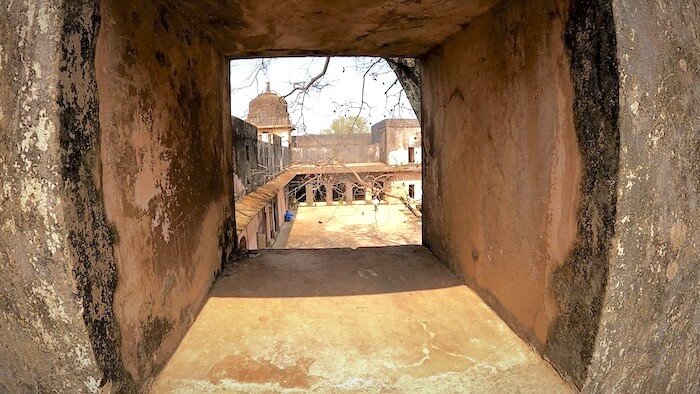
The Moti Mahal stands as a bridge to the past, it was constructed by the Gond King, Hriday Shah, also referred to as Hridayasaahi or Raja Hirde Shah or Hridayshah. He is believed to have been the last of the great Gond Kings who ruled over Northern Gondwana, known as Garha Mandla. Moti Mahal was constructed by King Hriday Shah.
The foundations of the fort were laid in the year 1651 and the construction was completed in 1667. The Moti Mahal was the power centre of the kings of Northern Gondwana for about 85 years before the capital was shifted to Mandla.

An inscription inside the courtyard of Moti Mahal bears the names of the line of kings, starting with Jadurai (Mentioned as Yadavraya) who is believed to have been the founder of the dynasty that ruled over northern Gondwana referred to as Garha Mandla. Hardly anything else is known about the kings who followed Jadurai, that is until the advent of the king Sangram Shah.
In one of the earliest books about the Gondwana Kingdom, titled, “The Story of Gondwana,” by Eyre Chatterton (1863-1950), the author writes, “It is to Sangram Shah that Northern Gondwana owes its greatness and fame until he came to the Gadi about A.D. 1480, the sway of the Gond kings was confined to the country around Jubbulpore and Mandla.”
Apart from Sangram Shah, Queen Durgavati occupies an important place in the annals of the history of the Gondwana Kingdom. She was the wife of Dalpat Shah, the son of Sangram Shah.
After the death of Dalpat Shah, the queen took over the reins of the kingdom, she died valiantly, defending her kingdom. King Hriday Shah is considered the last of the great kings in the pedigree of the kings of Garha Mandla that started with Jadurai, and Moti Mahal forms one of his enduring signatures on the sands of time.
Visiting Moti Mahal Ramnagar Mandla
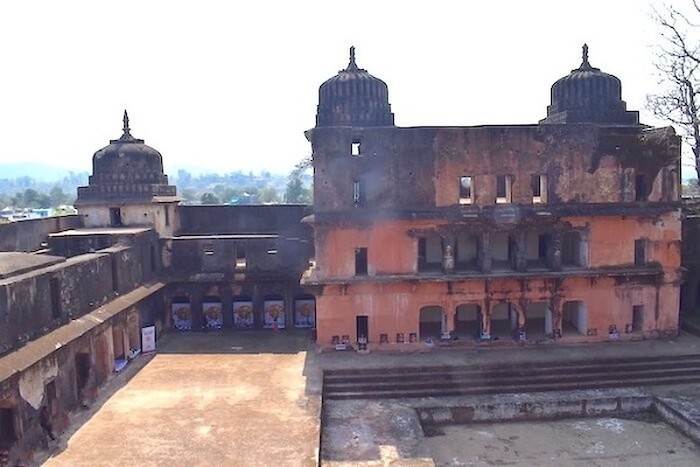
Our visit to Ramnagar’s Moti Mahal, Mandla, Madhya Pradesh, was nothing short of a revelation. It was a part of our Madhya Pradesh itinerary on the Times Passion Tribal Trail that had been organized in partnership with Madhya Pradesh Tourism.
The visit to Moti Mahal Ramnagar Madhya Pradesh acquainted us not only with Moti Mahal but almost literally opened the sluice gates for fascinating stories from the Gondwana Kingdom to tumble out from the obscure shadows of history.
A history that is not found in textbooks, a history that not many are aware of, a history replete with intriguing stories of chivalry, charisma, and conceit. Stories of great kings like Sangram Shah and Hriday Shah, and inspiring queens like Durgavati, in short, are the stuff that legends are made of.
When you are here, you understand how the history of Ramnagar, Mandla is inextricably interwoven with the 350-year-old history of Moti Mahal in Madhya Pradesh.
Inside The Intriguing Moti Mahal Ramnagar
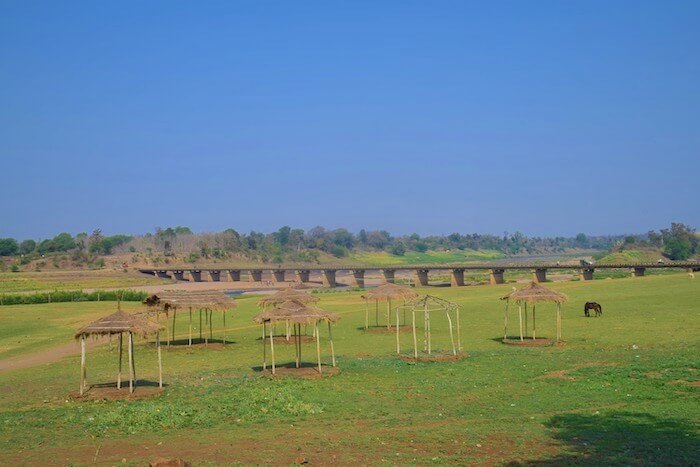
The imposing presence of Moti Mahal is felt as soon as you reach a bridge that spans the Narmada river some 14 kilometres from the historic town of Mandla. Moti Mahal was the centre of power for the rulers of Garha Mandla.
It was King Hriday Shah who was instrumental in moving the capital to Ramnagar from Chouragarh near present-day Jabalpur, where one of his predecessors, the great King Sangram Shah, had established as the capital.
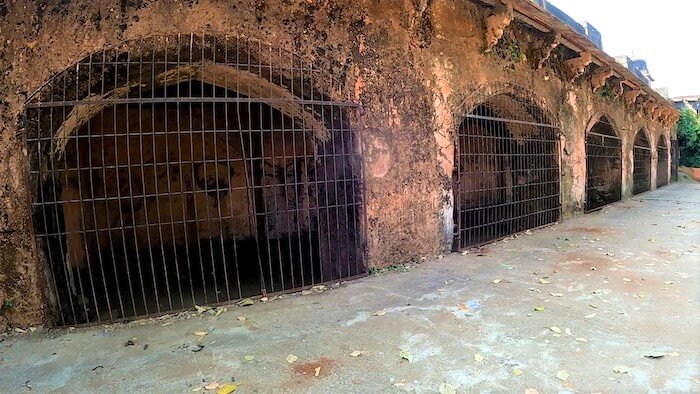
We entered through a massive iron gate and passed a row of elephant stables that overlooked the Narmada River. Hundreds of years ago, the place would have been alive with the trumpeting of royal elephants. But now it is enveloped in eerie silence.
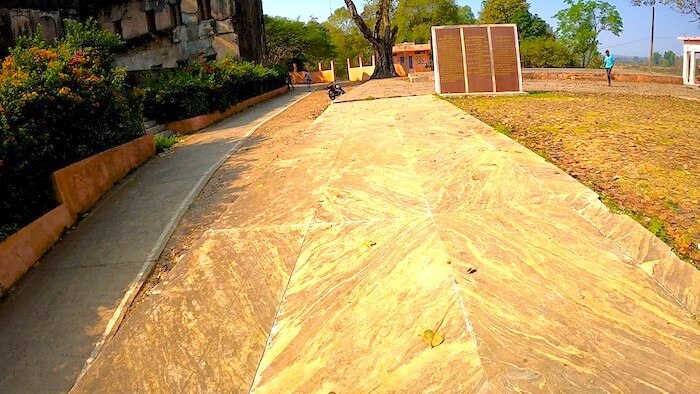
As we walk up an upwardly inclining path we come across a contemporary plaque that gives information about Hriday Shah. It eulogizes the king as, “The Great Emperor King Hridayasaahi.”
The rhythmic beating of drums serenaded us as we walked further and reached the narrow arched entrance that gave access to the interior of the citadel. A group of Gond dancers in colourful costumes welcomed us with a traditional dance.

The hypnotic beat of traditional drums known as Nagara resonated against the solid walls of the Moti Mahal. It was a traditional welcome accorded to royal visitors to the fort in the centuries gone by.
“Garh Mandla mein aapka swagat hai,” (Welcome to Garh Mandla), said Shri Rajeev Mishra, who guided us through the intricate passages of Moti Mahal. We thought that he was referring to the Ramnagar Fort (Moti Mahal) when he said Garh Mandla, however in hindsight we realized, that what he actually meant was the kingdom, ‘Garh Mandla”.
Architecture And Design Of Moti Mahal Mandla | Moti Mahal Fort
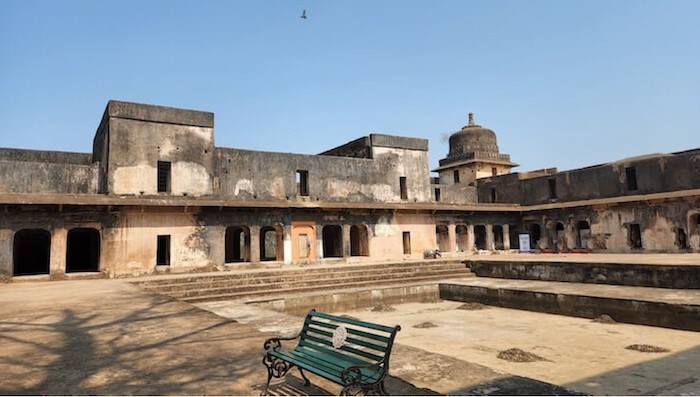
As soon as you step inside the fort and palace that Moti Mahal is, what you immediately notice is a huge rectangular courtyard with a pond in the centre, the pond which is dry now, must once have been filled with water.
Moti Mahal Mandla is a three-storeyed structure, and it is believed that in its heyday it towered to a height of 80 feet above the level of the Narmada river. However, owing to the passage of time and geographical changes, the fort is now much lower than it was.
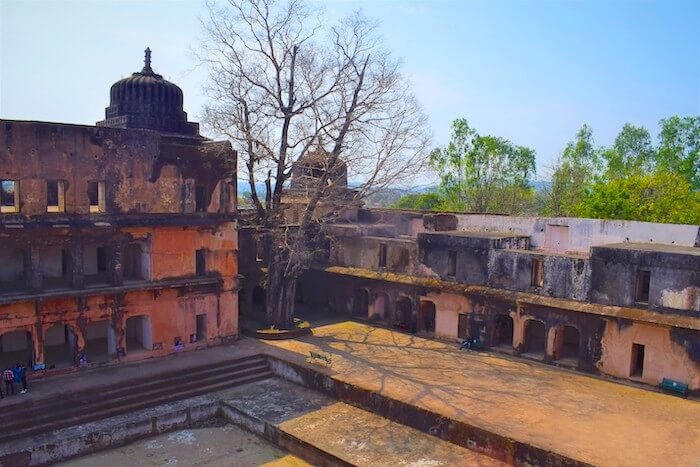
The influence of Mughal architecture on the construction of Moti Mahal is evident in the arches and the domes. King Hriday Shah spent a lot of time at the Mughal Durbar and was clearly influenced by its ethos.
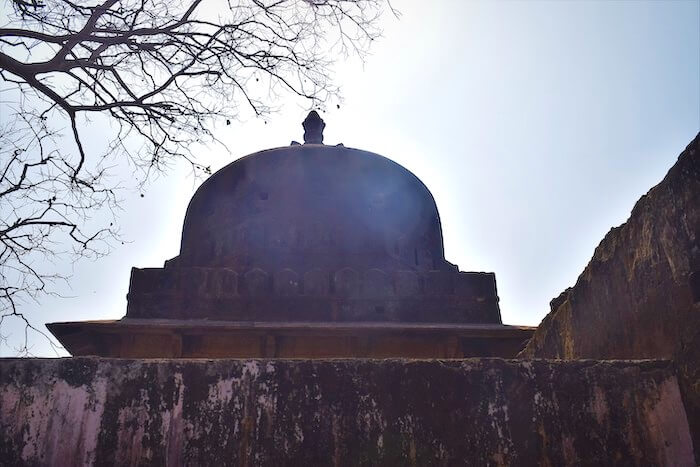
Moti Mahal Fort is a three-storeyed structure that has a terrace that overlooks the Narmada river.
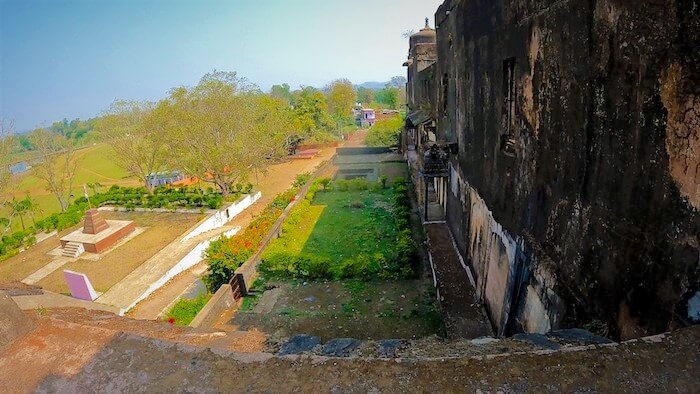
There are balconies too that overlook the sacred river, where the king and queen must have relaxed, enjoying the magical view of the flowing waters of the Narmada.
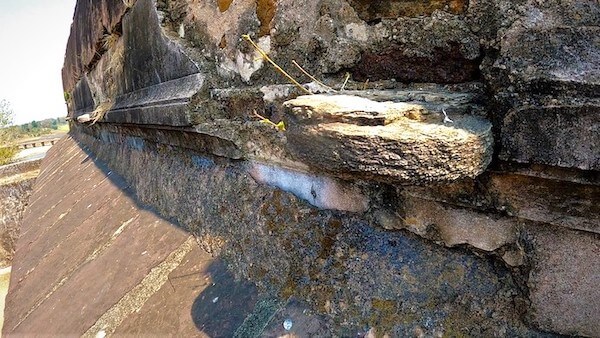
One can still see small outcroppings on the terrace which served as stands to position flambeaus (burning torches known as Mashaal in Hindi). There are different sized rooms on all the floors and including the royal bedrooms, meeting rooms, the Durbar hall, dancing hall, and royal kitchens.
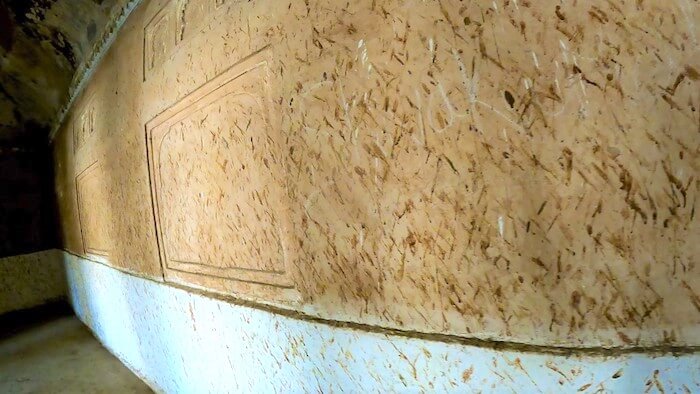
One of the rooms inside Moti Mahal has walls that are bare but have marks that indicate the place were earlier portraits of the kings used to hang and metal images were displayed. They are all gone now, destroyed by the forces of nature and also looted by invading marauders.
The lower levels of Moti Mahal house the elephant stables, and also dungeons where prisoners were incarcerated. There was a dark room where light never penetrated, that was reserved for solitary confinement.
The materials that gave shape to the monument that we know as Moti Mahal were primarily lime, mortar, gum, jaggery, black gram.
Moti Mahal is the jewel in the crown of the Gondwana Kingdom and stands as a silent paean to its rulers.
Secret Tunnels, Underground Passages, And Mazes In Moti Mahal Madhya Pradesh
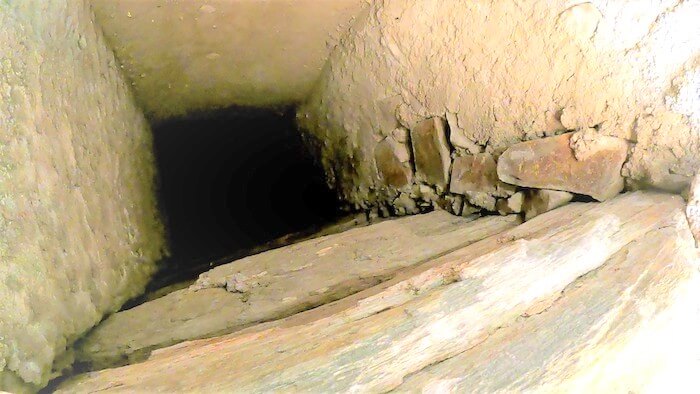
“One of the main features of Moti Mahal is the intricate web of tunnels and mazes and a dungeon where prisoners were kept and given an opportunity for rehabilitation,” said Shri Rajeev Mishra. We then followed Ganesh who is a security guard in Moti Mahal Madhya Pradesh and was doubling up as a guide inside the confusing and labyrinthine corridors of the palace of King Hriday Shah.
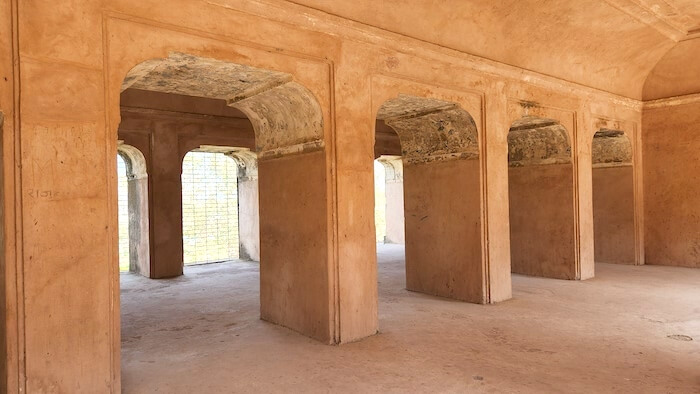
We pass through rooms supported by arched columns and connected by narrow passages to reach a relatively larger room.
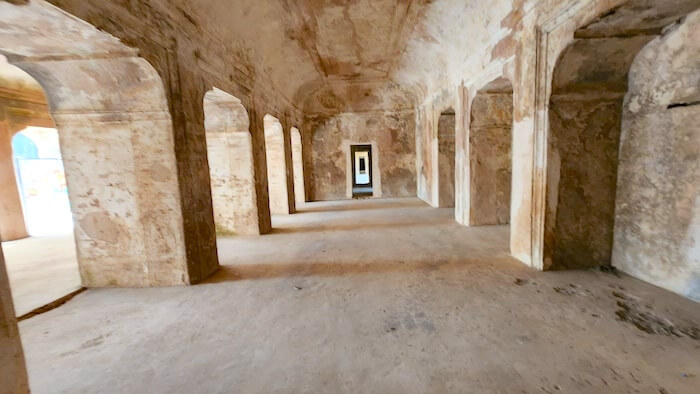
This, we were told was the Sabha Kaksh or Meeting Room where the King would have strategic meetings with his ministers and other senior members of the court.
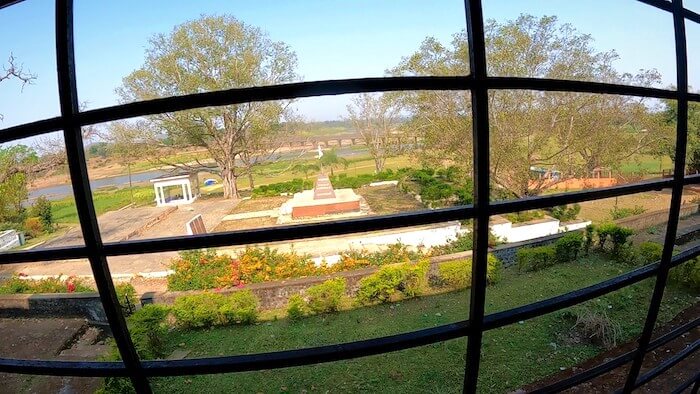
What was really remarkable about the room which was completely bare, was the spectacular view of the river Narmada, that it afforded.

We then alighted in single-file a narrow and steep flight of stairs that was pitch dark to reach the dungeon where prisoners used to be kept. Prisoners were brought here through the narrow stairs and incarcerated in the dungeons, there was also a “Kaal Kothri,” where no light penetrated which was probably used for solitary confinement.

It was at this level that we saw the remains of an ingenious water drainage system. The water from the pond located in the centre of the courtyard on the upper level would flow down through cavities across an inclined path and this water was then directed to a small pond outside the fort, where it was cleaned with the help of the sand at the bottom.
The cleaned water was then released back into the Narmada river. The 350-year old system surely has a lesson or two to be learned by today’s generations about keeping our rivers clean.
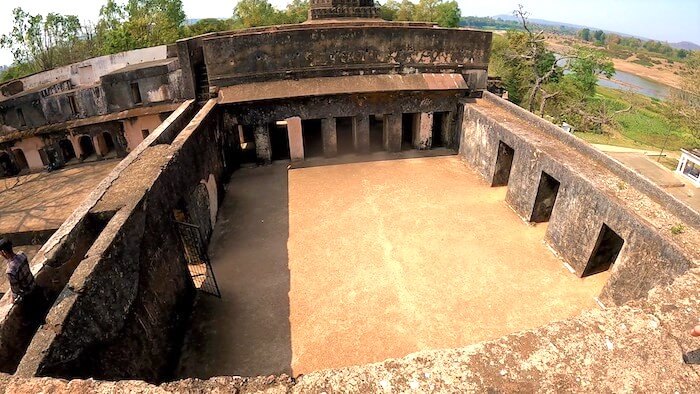
We then ascended two sets of dark and narrow stairs to reach the level where the king held court with his ministers and passed judgement on the prisoners who were brought there through the same stairs that we had used. A rectangular courtyard that is open to the sky is the place where prisoners stood, awaiting judgement.
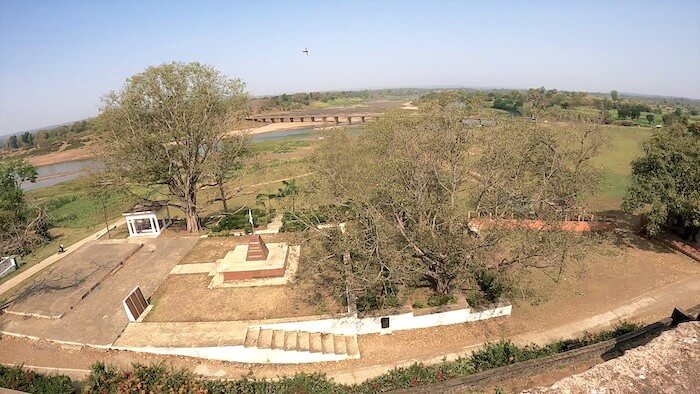
The ministers sat on one side of the courtyard while the king sat on the opposite side. There is a terrace that looks directly down upon the courtyard. In case the queen had to have her say in the proceedings, she would go to the terrace through a secret passage to give her statement.
Intriguing Places Not To Miss At Moti Mahal Mandla
The Moti Mahal Ramnagar has many surprises that will astound you in its twisting maze of corridors. But some of these are really unique and not to be missed.
The Horse Stables At Moti Mahal
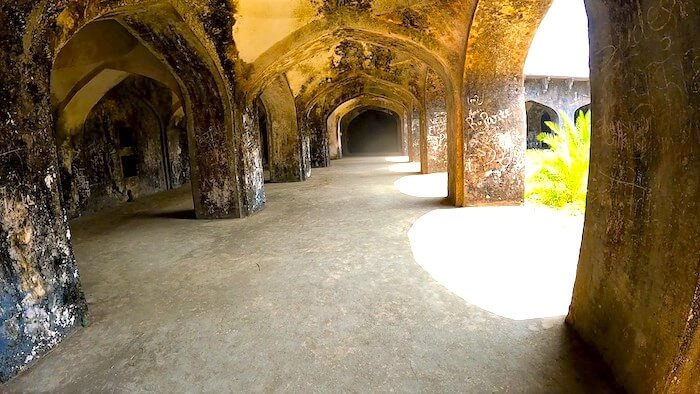
An entrance leads from the courtyard to another rectangular courtyard covered with grass and wild shrubs.
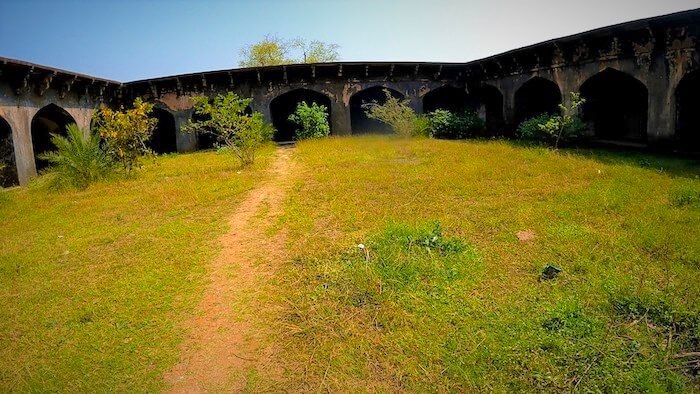
This courtyard is fringed on the sides with a structure with arched openings. This we were told were the Horse stables, the home of the royal horses.
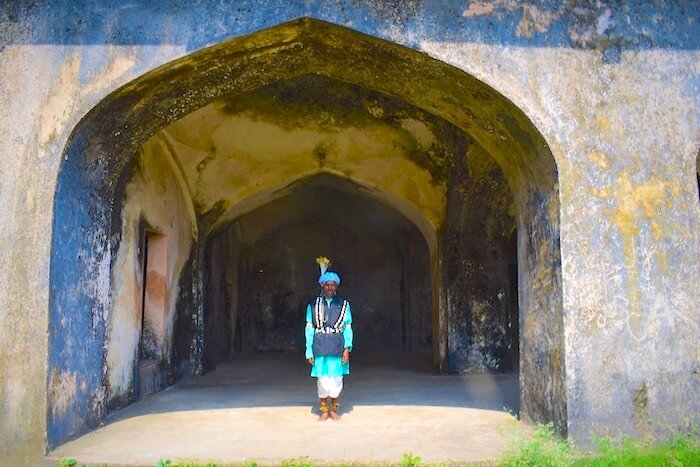
The Horse stables were constructed in an appealing manner, with columned arches adding to the visual beauty of the stables. The stables were truly fit for the horses of royalty.
Room With The Aroma of Basmati Rice At Moti Mahal Mandla
As we stepped into one of the many rooms that stood facing the courtyard, we were assailed by the sweet aroma of cooked Basmati rice, the fragrance of the rice, filled our nostrils. It turned out that the room had been the royal kitchen where rice must have been cooked centuries ago.
The fragrance of the cooked rice was locked in the walls of the room and due to humidity, the fragrance would waft in the air during summers. It was a unique experience to experience the fragrance that originated from the royal kitchen of Moti Mahal from hundreds of years ago.
The Royal Bedroom At Moti Mahal Mandla
Cool currents of air greeted us as we stepped into what was once the royal bedroom. The room was perceptible cooler than the other rooms. The temperature inside the room remained lower than the outside temperature and that of the other rooms. Of course, there was no air-conditioning, but it was the clever construction and engineering genius of the builders that ensured more comfort for the king, after a hard day’s work.
The Defense System of Moti Mahal Mandla
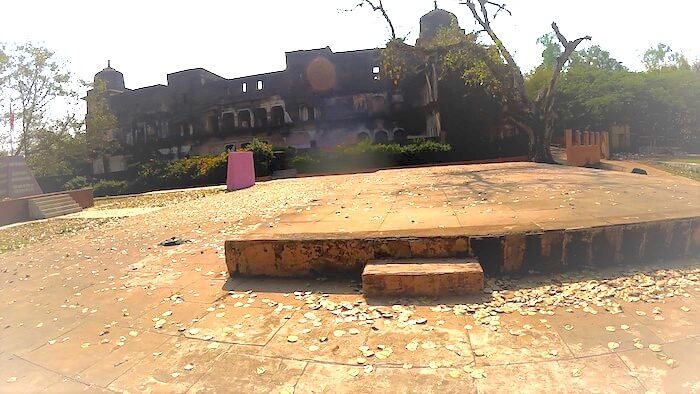
Moti Mahal was constructed beside the Narmada river owing to its locational advantage. The river itself acted as the first line of defence for the fort. The fact that originally the fort stood at a height of about 80 feet above the level of the river, ensured that soldiers stationed in the fort had a vantage view of the river and its surroundings and would be prepared for any attack.
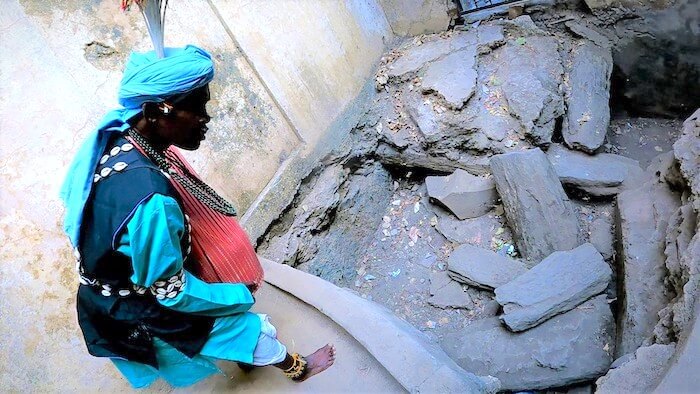
Inside the Moti Mahal, the maze of passages and secret tunnels added another layer of defence. They were constructed as escape routes for the king and his entourage if the situation arose. One of the tunnels according to local myth leads all the way to the Madan Mahal near Jabalpur, located more than 100 kilometres away.
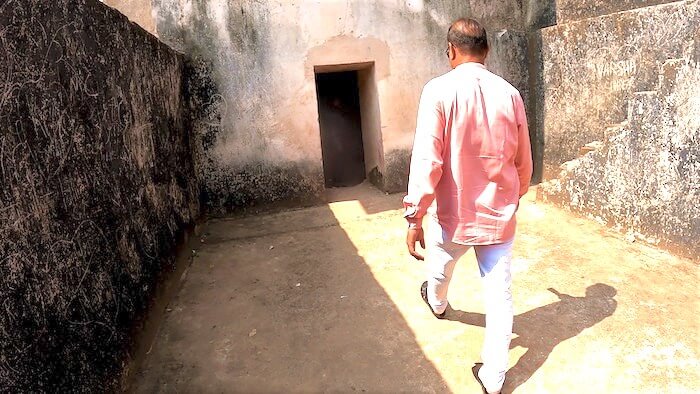
There were secret passages that led from the palace to the Narmada river to enable the queen and other royal womenfolk easy and safe access to the river.
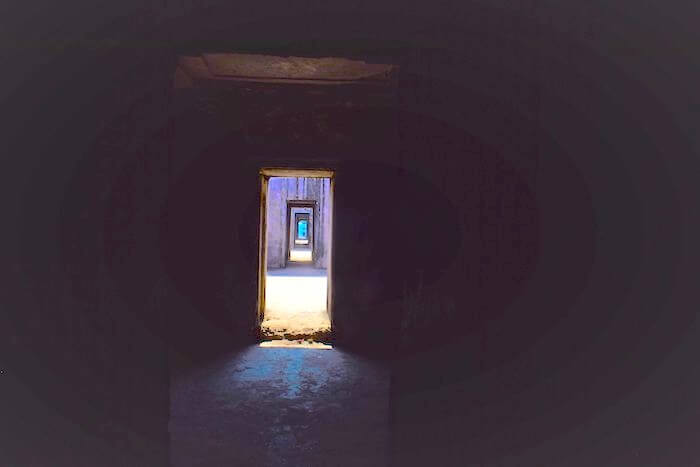
A maze of passages, many of them cul-de-sacs was designed to confuse enemy intruders and set them up for a quick ambush.

In addition, there were many stairways that connected the different levels that were built to hinder the movement of enemies who gained access to the fort. These stairs were built almost at an incline of ninety degrees and meant to injure intruders.
In spite of these elaborate defence mechanisms, constant enemy attacks, particularly from the Marathas, meant that the king had to think in terms of shifting to safer grounds and this is exactly what was done.
The Shift From Moti Mahal To Mandla

The capital of Garha Mandla was shifted to the more secure shores of the Narmada river in Mandla during the time of Narendra Shah, the grandson of Hriday Shah. The Narmada river formed a natural peninsula in Mandla and also had greater depth. This secured the capital from three sides with a natural boundary.
This was enhanced by deep trenches that surrounded the land. Fourteen fortification gates called Burj (Tower) along with a fort secured the city and the Gond kings ruled from Mandla for about 103 years, before it was besieged by the Marathas.
Who Was Hriday Shah?
History records that King Hriday Shah was the 54th king of the Gond kings of Garha Mandla. It also regards him to be the last of the great kings of the dynasty. Hriday Shah was a man of the world and spent a lot of time at the Mughal court of Shah Jehan. It is apparent that he was deeply influenced by the Moghuls with respect to architecture, music, art, and culture.

It was Hriday Shah who moved the headquarters of the Garha Mandla kingdom from Chouragarh near present-day Jabalpur, building the Moti Mahal on the banks of the Narmada in Ramnagar. He was a great builder in the mould of his mentor Shah Jehan, and apart from the Moti Mahal, he also built beautiful structures like the Rai Bahadur Kothi or Mantri Mahal for his minister, Dewan Rai Bhagat.
Another beautiful structure that is contemporary to the Moti Mahal is the Begum Mahal which was also built by Hriday Shah. This palace is believed to have been built for his queen, Chimni Devi. It is believed that she was a Mughal princess with whom Hriday Shah fell in love during his time at the Mughal Durbar.
Another structure that is in ruins today is the Badal Mahal, a structure that was built by Hriday Shah for his Generals and other soldiers.
The Vishnu Mandir is another beautiful structure not far from Moti Mahal. It is a temple dedicated to Lord Vishnu and is believed to have been built by Sundari Devi, a queen of King Hriday Shah.
Hriday Shah was passionate about music and trained in music at the Mughal court. He even wrote two musical treatises named, “Hriday Koutuk,” and, “Hriday Prakash.”
As we left the lengthening shadows of the Moti Mahal behind, we were thankful that we had an opportunity to experience a part of history, that not many are aware of, the history of an entire dynasty that ruled over the North Gondwana Kingdom for centuries and has left its mark across Central India.
Images Of Moti Mahal Madhya Pradesh
We leave you with some haunting images of Moti Mahal Madhya Pradesh, check out some useful information below for planning your own trip to Moti Mahal.
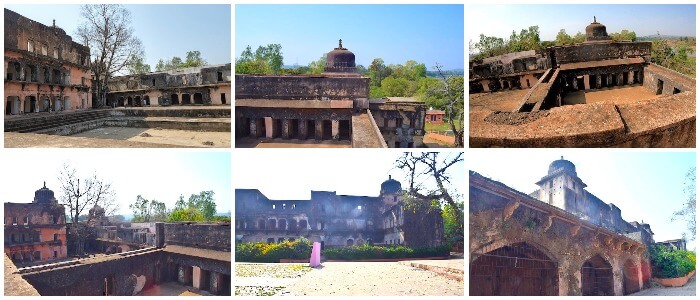
How To Get To Moti Mahal Ramnagar
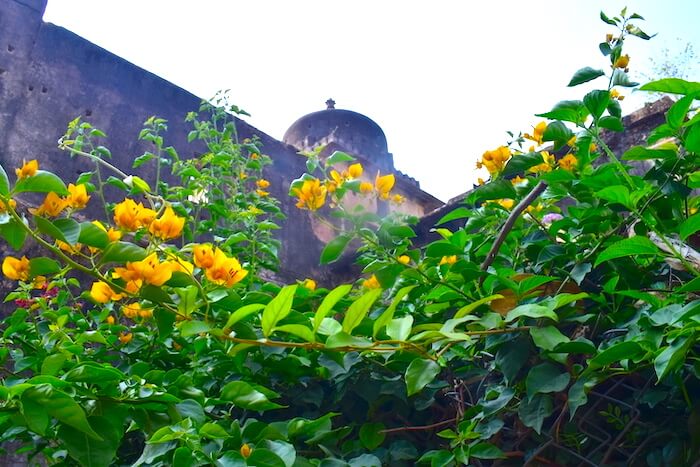
- Moti Mahal is located in Ramnagar, Madhya Pradesh, India
- Moti Mahal Address is JG76+RGF, Ramnagar, Madhya Pradesh 481661
- Moti Mahal is at a distance of about 17 kilometres from Mandla
- Moti Mahal Ramnagar is about 112 kilometres from the city of Jabalpur
- Moti Mahal Ramnagar Mandla MP is about 422 kilometres from the capital city of Bhopal
- The nearest airport to reach Moti Mahal is in Jabalpur
If you planning to visit the magnificent Moti Mahal, you can book your flight tickets right here through, TripAdvisor or CheapAir or Cleartrip or Makemytrip or Priceline and fly to Jabalpur. If you are thinking of a road trip from Jabalpur or Bhopal, do check out the rental car and bus options.
Where To Stay When Visiting Moti Mahal | Mandla Ramnagar
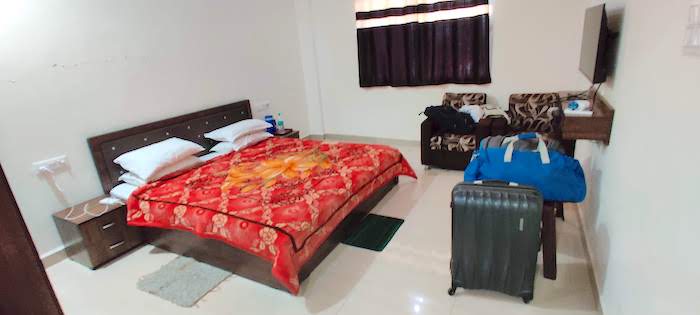
If you are planning a trip to Moti Mahal, you would need to stay in the historic city of Mandla. Many believe that the old name of Mandla is Mahishmati. There are not too many options for staying in Mandla which is a small town. We stayed at Shikhar Palace, which offers decent air-conditioned rooms and good food.
You can book Shikhar Palace or any other hotel in Mandla, Jabalpur, Bhopal, or anywhere else right here!
You can book Hotels/Resorts in Mandla or any destination right here through any of the options below: TripAdvisor or Cleartrip or Makemytrip or Priceline and save a lot by getting the best deals on booking your stay.
| Click to book the best hotels in Mandla or the best hotels in Madhya Pradesh |
|---|
Madhya Pradesh – A Travelers Dream Come True
There is so much to see and experience in Madhya Pradesh. If you prefer package tours and looking for these, you can plan your Madhya Pradesh itinerary and book your MP trips, right here. So go ahead and book online places to see in Madhya Pradesh and popular activities in MP and cover attractions in Madhya Pradesh.
| Click here to know more and book MP Tours & Best Attractions in MP |
|---|
Moti Mahal – FAQ
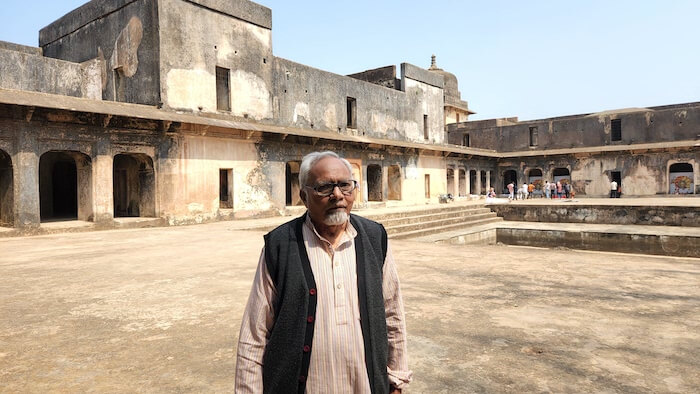
Where is Moti Mahal?
Moti Mahal is located on the banks of the Narmada river in Ramnagar near Mandla, Madhya Pradesh.
Who built Moti Mahal?
Moti Mahal was built by the Gond King Hriday Shah.
When was Moti Mahal Built?
The construction of Moti Mahal was completed in 1667, while its foundation stone was laid in 1651.
Our visit to Ramnagar’s Moti Mahal Mandla in Madhya Pradesh was part of a tribal trail curated and organized by Times Passion Trails ( Times of India ) and Madhya Pradesh Tourism under the #DekhoApnaDesh and #AzadiKaAmritMahotsav initiative. The views and opinions expressed in this blog post are our own. #timespassiontrails #tribaltrail #TimesofIndia #MPTourism #HeartOfIndia #MadhyaPradesh
Below are some useful resources to help you book flights, hotels, and tours! And also clothes, luggage and accessories for your trip!
Flights – TripAdvisor or CheapAir or Cleartrip or Makemytrip or Priceline
Tours – Click here to book top tours around the world
Hotels – Click to book the best hotels/resorts
Choose best stay options with TripAdvisor or Cleartrip or ixigo or Makemytrip or goibibo or Hotelscombined or Priceline
Apparels – Click to buy Menswear or Womenswear or Kidswear
Accessories/Luggage – Click to buy Accessories and Luggage items
Beauty Products – Click to buy Personal Care and Beauty Products
Do You Love Traveling?
Do you want to know how to travel the world? We have put together a very useful travel resources page with the best travel tips. Go check it out now.
Thanks for visiting our site Voyager – imvoyager.com and taking the time to read this post!
If you wish to collaborate/work with us then reach us at [email protected]
We’d love it if you’d comment by sharing your thoughts on this post and share this post on social media and with your friends.
Follow our journey on our social media channels:
Facebook Twitter Instagram Pinterest YouTube
60+ Million Users Trust TripAdvisor With Their Travel Plans. Shouldn’t You?

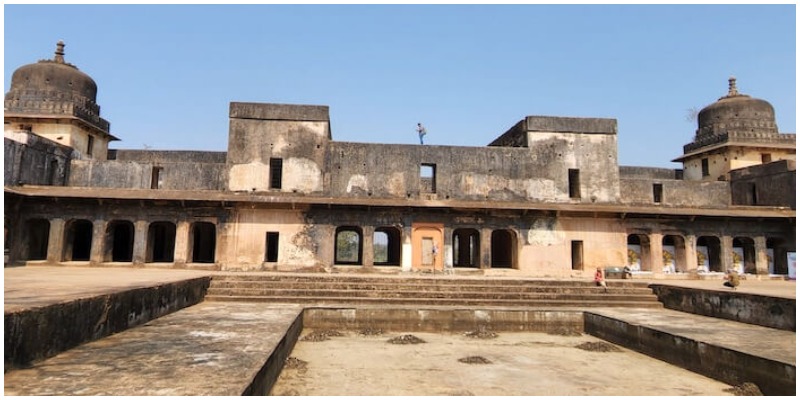
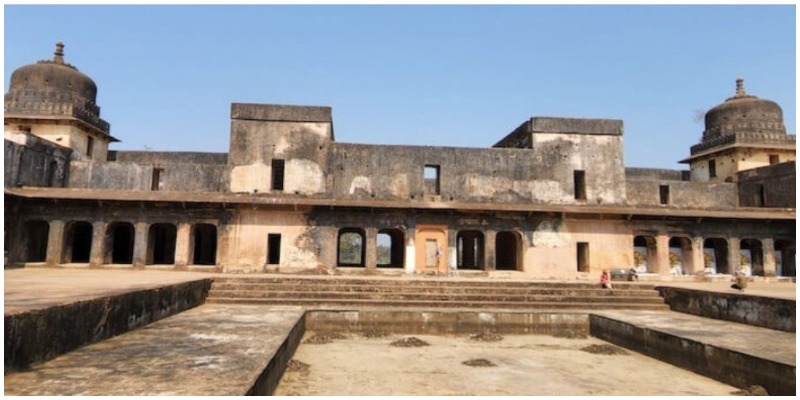
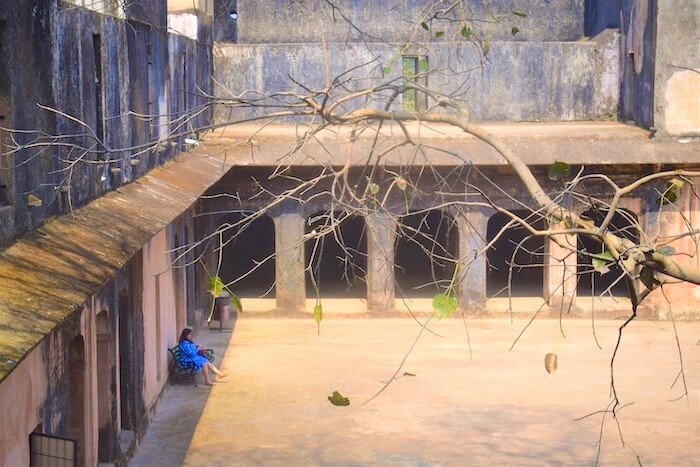
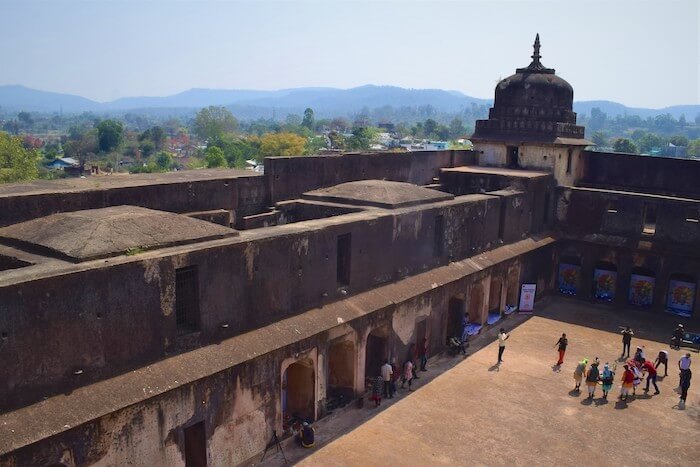
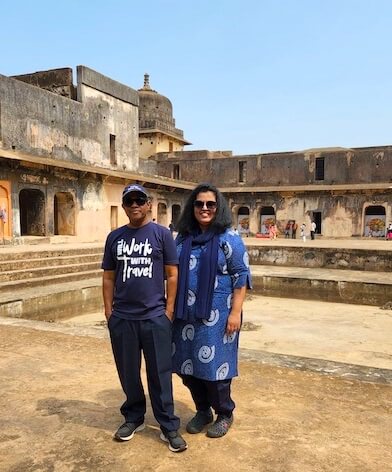

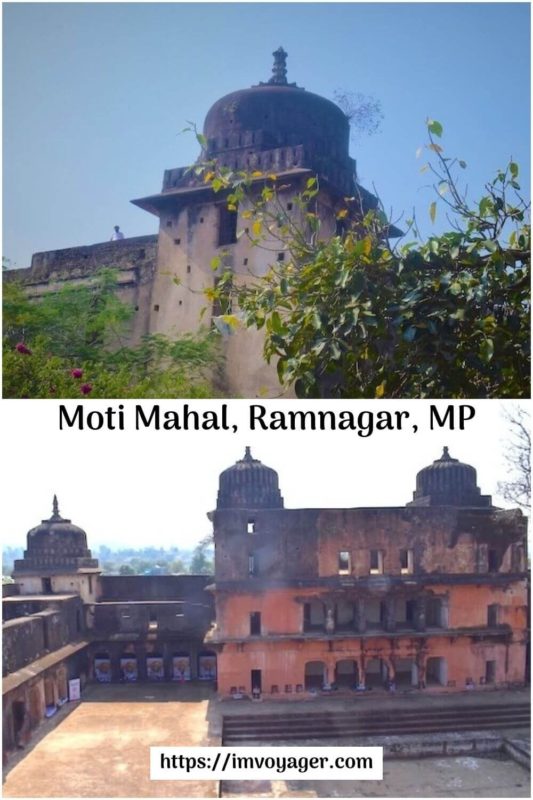

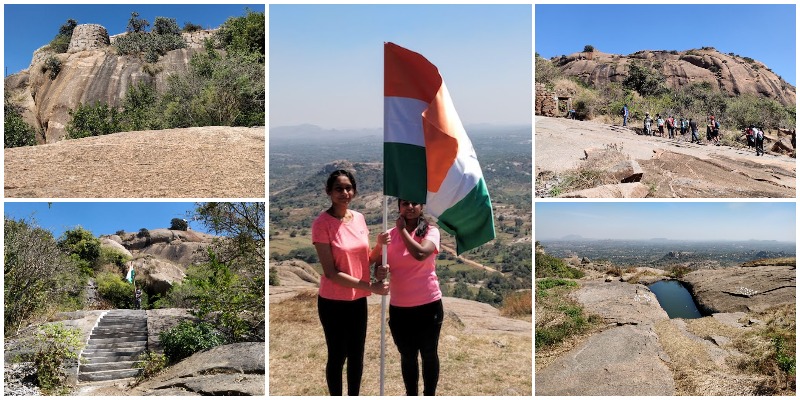
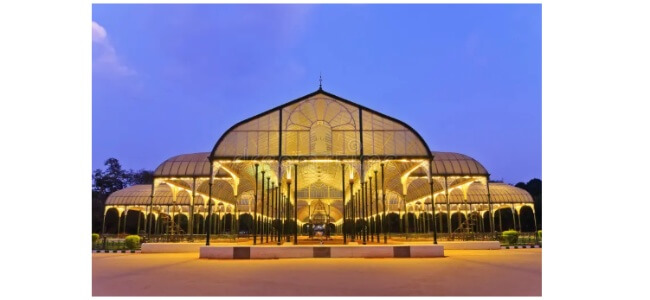

I would absolutely love to see that in person one day! I love all that old architecture and all that history.
This would be such a neat place to explore. I always enjoy learning the history of other spots in the world.
I love reading about different countries to learn more about them. I’m not much of a traveler. Beautiful pictures and thanks for sharing.
What a cool place to visit. I need to check this place out.
What a fascinating place to visit. I love the buildings and the history behind each building.
You had such an interesting journey to the 350 Year Old Moti Mahal Mandla – Madhya Pradesh’s Hidden Gem. So many different places to see and explore. I can’t imagine such a trip.
Wow, that is a really neat place. I’d love to be able to check that out sometime. Great photos!
It must have been interesting to explore the narrow corridors there and have a look around. A package tour might be a good idea.
This sounds like a place with such a rich history. I would love to visit some day
Moti Mahal Mandla looks and sounds so exotic. I love traveling to faraway places and learning about other cultures. Thanks for sharing.
It’s a place full of history and culture! Love to discover the world around us!
Wow! That looks like a really amazing and a wonderful place to visit and explore! I would love to go there!
Moti Mahal is surely one of those places that I would love to go. The history and the architecture is intriguing and I have always loved to visit a fort. I have been to MP only once and I barely scratched the surface. I need to plan again and I will add this to my list.
Among all the surprises of Moti Mahal, the Kaal Kothri gives me goosebumps. Mazes and labyrinths in old Indian palaces attract me a lot. Madhya Pradesh has so many such surprises. Wonder how you pull out such gems!
Every palace has a story to tell and sometimes it is disheartening to see that history books do not give them their due value. I am sure posts like this will add value to the place and create curiosity among visitors to witness the history by themselves.
Every fort has a unique piece of history attached to it, which makes it fascinating. Thanks for familiarising me with Moti Mahal through your post.
Wow your post is a complete guide to visit and explore Moti mahal. the place seems like have a great historical importance. would love to visit this place when plan my next India visit.
A beautiful piece of historical travel diary which narrates about a monument which, inspite of its importance in history, failed to get popular as much as other Rajasthan forts and monuments. Special thanks to you for this content.
Interesting place! Appreciate you sharing your travel and journey. As the travel restrictions slowly ease-up, we could all go travel and see the great creation of God again and explore.
This looks beautiful. I really enjoy reading your travel blogs. Thank you for introducing us to these amazing places. l would definitely visit this one.
I have been at this historic place. It is indeed a gem, hidden at the center of India
Wow it really looks amazing. Hope one day I visit this place. Your discription and pictures explained alot abut this historical place.